|
|
|
|
|
|
Even before his trip to Japan,
Wright had an interest in Japanese prints. Wright lent one
of his prints to an exhibit of Suzuki Harunobu’s work held
at the Caxton Club
on February 4, 1905 in the Fine Arts Building, Chicago. With
his forthcoming trip in mind, the exhibit afforded Wright
the opportunity to connect with wealthy collectors and
inform them of his upcoming voyage. Ten days later, on
February 14, 1905 Frank Lloyd and Catherine Wright departed
Oak Park for a trip to
Japan.
They headed west, and one week later departed from
Vancouver, BC on the Empress of China with
Ward and Cecilia
Willits (1901 - S.054). After two weeks at sea, they
arrived in Yokahama, Japan on March 7th. For seven and a
half weeks they toured Japan, finally arriving back to Oak
Park during the middle of May.
While in Japan, Wright
invested heavily in Japanese Prints as well as other items.
One year later Wright exhibited over two hundred Hiroshige
woodcut colour prints at The Art Institute of Chicago from
March 29 through April 18, 1906, entitled "Hiroshige.
An Exhibition of Colour Prints from the collection of Frank
Lloyd Wright". He also purchased Japanese paper
while in Japan which Wright used for the exhibition catalog.
The solo exhibition was a first for Wright and for
Hiroshige’s work.
Two years later Wright loaned
over two hundred prints to an extensive exhibition of
Japanese Colour Prints from March 5-25, 1908, again at The
Art Institute of Chicago, titled "A Loan Exhibition of
Japanese Colour Prints". The committee in charge, and
major contributors, were Clarence Buckingham, Frederick W. Gookin, J. Clarence Webster and Frank Lloyd Wright. It was
the largest exhibit of Ukiyo-e prints ever displayed in
America. Wright designed the exhibition installation for the
Art Institute. Wright’s display consisted of a long
horizontal panel suspended above the ground, secured on each
end by a pair of vertical pedestals. Included with the
designs for the exhibition was a Japanese Print Easel or
Stand.
The print was held in a
tall
vertical frame that intersected the base, and floated above
the surface it was placed on. The low base was designed to
hold a small vase for flower arrangements or other
decorative items. The overall design was very consistent
with Wright’s prairie style. Although very vertical in
appearance, this first Print Stand appears to be about three
feet in height and was designed to be placed off the ground
at eye level.
A taller variation,
approximately six feet in height, and designed to set on the
floor, appeared in the
Taliesin Photograph Album from
1911. It was placed in the Dining Room at Taliesin I. Wright
began building Taliesin I in 1911. On August 15, 1914, it
was destroyed by fire. On January 28, 2005, the Wisconsin
Historical Society acquired the album that included
important photographs documenting Taliesin I between
1911-1912. One of those photographs included this image of
the Dining Room. Courtesy of the Wisconsin Historical
Society.
Five Print Stands were displayed
again at an exhibition of Wright’s work entitled "The Work
of Frank Lloyd Wright" at The Art Institute of Chicago in 1914. The
photograph documenting the exhibition features a Puppet
Theater designed in 1908 for his son Llewellyn. The engraved
masque reads, "To Fashion Worlds in Little - Making Form As
God Does One With Spirit - So God Makes Use Of Poets", an
adaptation of a passage from Richard Harvey's "Taliesin". Of
note, this quote was used three years before Wright
began building Taliesin I in 1911. Also visible in the
photograph is a Coonley Playhouse window (1912 - S.1912) and
tthree Print Stands. The shorter version seen on the left
behind the Puppet Theater, the taller version seen on the
right, and a shorter desk top version in the center. Of interest is the addition to the base, possibly
modified to increase stability and compensate for the
height. A second image, photographed from the reverse side
of the Puppet Theater clearly shows five Print Stands in
three |
|
variations. The two taller floor
versions are seen on the far left and the right. The shorter
table top version is to the right of center. Not seen before
are the two desk top versions seen in the foreground on the
left, and behind it in the background.
By 1915, Wright had placed
two additional taller floor Print Stands in the Living Room
at Taliesin II. "The Architectural Record", October,
1915, published the first interior photograph of Taliesin
II. This was taken after rebuilding from the fire of August
15, 1914, but before August, in time to go to production for
publishing in October, 1915. Most likely photographed by
Henry Fuermann and Sons (see image two) in July or August,
1915. Courtesy The Architectural Record. The second Print
Stand, seen on the right, is setting on the built in shelf.
On the base is a Japanese figurine. The third Print Stand on the far left, is
obscured in this photograph. A second photograph, taken from
a slightly different view, clearly shows the three tall
floor Print Stands, especially the one on the far left.
Photographed by Henry Fuermann and Sons, dated incorrectly,
but courtesy of the Wisconsin Historical Society.
Taliesin II was photographed
again by Henry Fuermann and Sons circa 1917-1919, clearly
showing three Print Stands. There are many similarities
which date the 1915 image and this image close together. The
vase on the top shelf in the far left corner. Many items
decorating the dining room table are exactly the same. The
print and print stand on the far right atop the end table
are the same. But there are also subtle changes that would
date it at a later time. The adjustable wall lamp on the
left has been adjusted differently and has been adorned. The
print stand on the left has been moved. The ceiling in the
far left corner has added triangles. The figurine that was
on the far right has now been moved to the dining table
centerpiece. The small throw rug that was running
horizontally just to the right of the dining table is now
placed vertically. The Winged Victory model on the right has
been replaced by a vase. The book shelves are now full of
books. The third print stand that was on the left has been
moved to the right as well as matching wall lamp on the
right. A pelt has also been draped over a chair on the far
right as well as the dining room bench on the left. There
are many more plates and vases.
In April 1925, fire struck
Taliesin again and destroyed the living quarters. Wright
rebuilt again, expanding and enlarging the Dining and Living
Room. Whether damaged in the fire or moved to a different
location, they are not evident in the photograph.
Of interest is the Sherman M.
Booth Residence (1915 - S.187) adaptation of the Print Stand
as a Floor Lamp. Booth, Wright’s attorney and a developer,
first approached Wright in 1911 to design an
elaborate home
in Glencoe, on Chicago’s North Shore. Wright was asked to
scale back the design, and in 1915 the Booth Residence was
constructed, along with three sculptures (S.185.1-185.3), a
bridge (S.186) and five other homes (S.188-192). Built for
the Residence in 1915, the Lamp measures sixty-five inches
high, 10 inches wide and 14 inches deep. Constructed of
mahogany, the shade is a silk fabric, with the horizontal
element just below the Print was enlarged to form a shelf
below the shade just above mid point. The base is a
different design.
Wright designed an additional
Floor Lamp variation for the Henry J. Allen House, Wichita,
Kansas, "Decorative Designs", Hanks, p128.
In November, 2010 my
son-in-law, James C. Rust gave us a table top version of the
Print Stand. Not having original plans to work with, he
created a very accurate adaptation of the shorter table top
Print Stand. Thirty-six inches in height, eight in width and
twelve inches in depth, it is made of oak, stained with
walnut, and coated with a satin finish. What once was an
obscure two dimensional element has come to life as a
detailed three dimensional object illustrating the mind of
Frank Lloyd Wright.
November 2011
|
|
|
|
|
|
Links |
|
Exhibition 1908 Taliesin
1911 Work of Wright 1914
Taliesin 1915
Taliesin Circa 1917-1919 |
|
Adaptation
Booth Floor Lamp Books
& Articles |
|
|
|
|
Exhibition of Colour Prints 1908 |
|
|
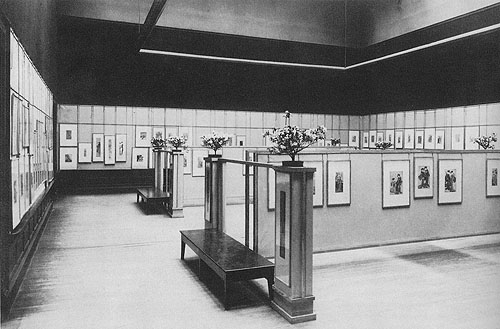 |
|
1A: 1908. Wright loaned
over two hundred prints to an extensive
exhibition of Japanese Colour Prints from March 5-25, 1908, at The
Art Institute of Chicago, titled "A Loan Exhibition of
Japanese Colour Prints". The committee in charge, and
major contributors, were Clarence Buckingham, Frederick W. Gookin, J. Clarence Webster and Frank Lloyd Wright. It was
the largest exhibit of Ukiyo-e prints ever displayed in
America. Wright designed the exhibition installation for the
Art Institute. Wright’s display consisted of a long
horizontal panel suspended above the ground, secured on each
end by a pair of vertical pedestals. Courtesy of the Art
Institute of Chicago. |
|
Int3 |
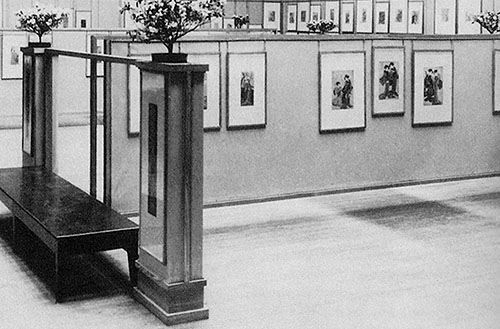 |
| 1B:
1908. Detail
of the exhibition display designed by Frank Lloyd Wright. |
| |
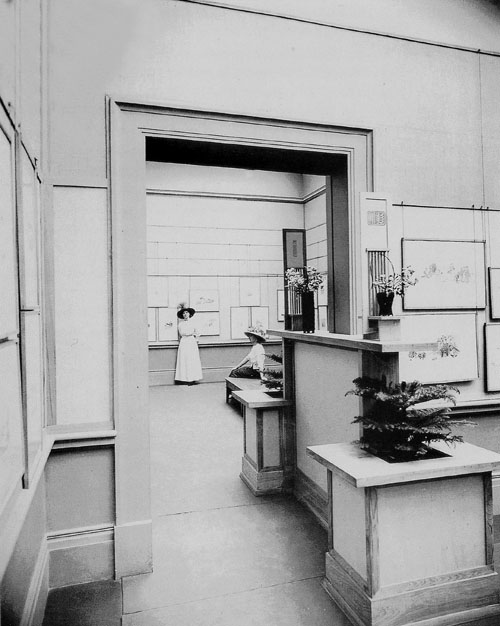 |
| 2A:
1908. Included with the
display designs for the exhibition was a Japanese Print Easel or
Stand. Courtesy of the Art Institute of Chicago. The Print
Stand consisted of a tall vertical frame that intersected
the base, and floated above the surface it was placed on.
The low base was designed to hold a small vase for flower
arrangements or other decorative items. The overall design
was very consistent with Wright’s prairie style. Although
very vertical in appearance, this first Print Stand appears
to be about three feet in height and was designed to be
placed off the ground at eye level. Courtesy of the Art
Institute of Chicago. |
| |
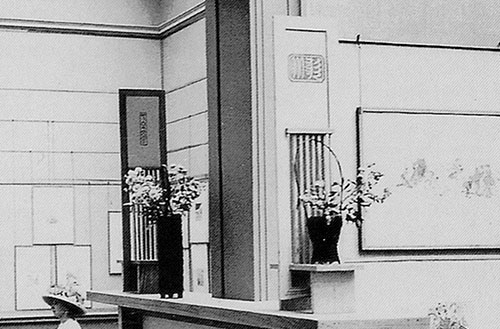 |
| 2B:
1908. Detail
of the Print Stand designed by Frank Lloyd Wright. It
consisted of a tall vertical frame that intersected the
base, and floated above the surface it was placed on. The
low base was designed to hold a small vase for flower
arrangements or other decorative items. The overall design
was very consistent with Wright’s prairie style. Although
very vertical in appearance, this first Print Stand appears
to be about three feet in height and was designed to be
placed off the ground at eye level. |
|
1908ps |
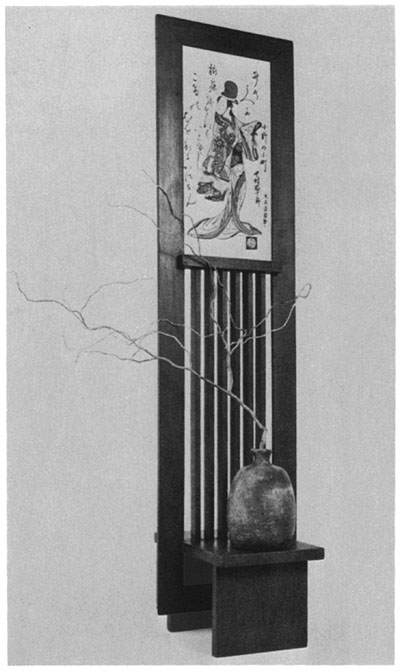 |
| 3:
Circa 1908. The Frank Lloyd Wright designed Print Stand
consisted of a tall vertical frame that intersected the
base, and floated above the surface it was placed on. The
low base was designed to hold a small vase for flower
arrangements or other decorative items. The overall design
was very consistent with Wright’s prairie style. Although
very vertical in appearance, this first Print Stand appears
to be about three feet in height and was designed to be
placed off the ground at eye level. |
| |
| |
| |
|
|
Taliesin Photo Album 1911 |
|
|
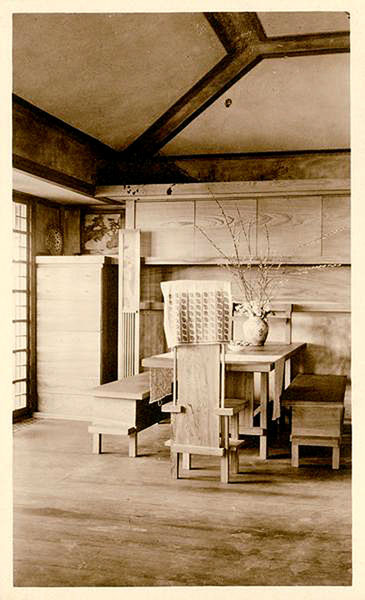 |
|
Dining Room, Taliesin I,
1911. A taller
variation of the Print Stand, approximately six
feet in height, and designed to set on the
floor, appeared in the
Taliesin
Photograph Album from
1911. It was placed
in the Dining Room at Taliesin I. Wright began
building Taliesin I in 1911. On August 15, 1914,
it was destroyed by fire. On January 28, 2005,
the Wisconsin Historical Society acquired the
album that included important photographs
documenting Taliesin I between 1911-1912. One of
those photographs included this image of the
Dining Room. Courtesy of the Wisconsin
Historical Society. |
| |
| |
| |
| |
|
|
The Work of Frank Lloyd Wright 1914 |
| |
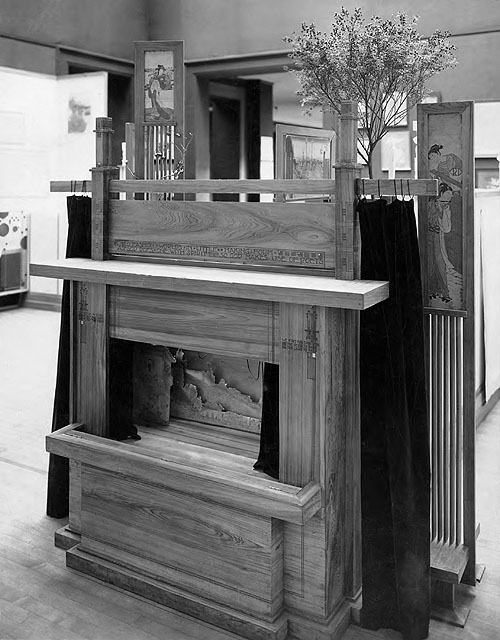 |
|
1: The Art Institute of Chicago
in 1914. The Print Stand was displayed
again at an exhibition of Wright’s work entitled "The Work
of Frank Lloyd Wright" at The Art Institute of Chicago in
1914. The photograph documenting the exhibition features a
Puppet Theater designed in 1908 for his son Llewellyn. The
engraved masque reads, "To Fashion Worlds in Little - Making
Form As God Does One With Spirit - So God Makes Use Of
Poets", an adaptation of a passage from Richard Harvey's
"Taliesin". Of note, this quote was used three years before Wright
began building Taliesin I in 1911. Also visible in the
photograph is a Coonley Playhouse window (1912 - S.1912) and
three Print Stands. The shorter version seen on the left
behind the Puppet Theater, the taller version seen on the
right, and a shorter desk top version in the center. Of interest is the addition to the base, possibly
modified to increase stability and compensate for the
height. Courtesy of the Frank Lloyd Wright Preservation
Trust. |
| |
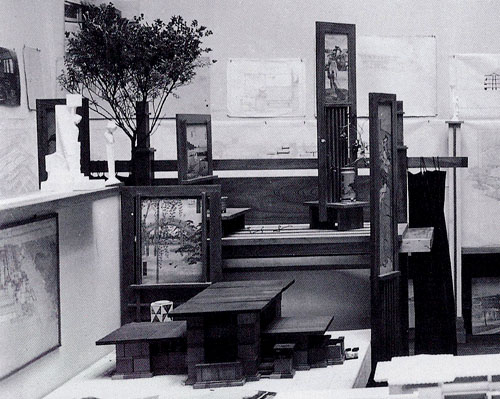 |
|
2: The Art Institute of Chicago
in 1914. Reverse side of the Puppet Theater. There are
five Print Stands visible in this image. The two taller
floor versions are seen on the far left and the right. The
shorter table top version is to the right of center. Not
seen before are the two desk top versions seen in the
foreground on the left, and behind it in the background.
Photographed by Henry Fuermann & Sons. Courtesy of the Frank Lloyd Wright
Archives, Scottsdale. |
| |
| |
| |
| |
|
|
Taliesin
II Dining Room, 1915 |
| |
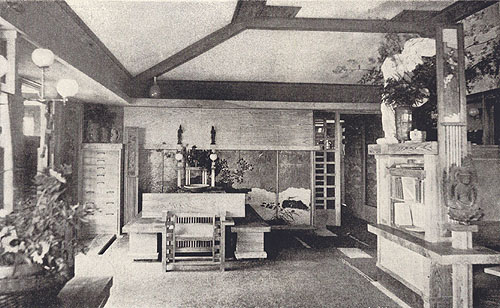 |
|
Dining Room,
Taliesin II, 1915. By 1915, Wright had
placed two additional taller floor Print Stands
in the Living Room at Taliesin II. "The Architectural Record", October,
1915, published the first interior photograph of Taliesin
II. This was taken after rebuilding from the fire of August
15, 1914, but before August, in time to go to production for
publishing in October, 1915. Most likely photographed by
Henry Fuermann and Sons (see image two) in July or August,
1915. Courtesy The Architectural Record. The second Print
Stand, seen on the right, is setting on the built in shelf.
On the base is a Japanese figurine. The third Print Stand on the far left, is
obscured in this photograph. A second photograph, taken from
a slightly different view, clearly shows the three tall
floor Print Stands, especially the one on the far left. See
next image. |
|
|
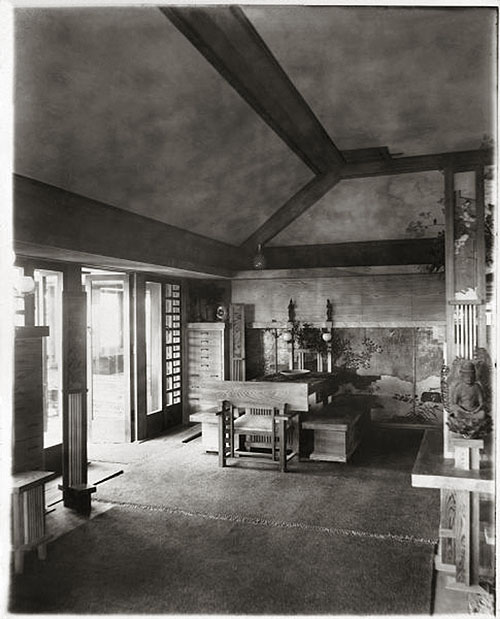 |
|
Dining Room,
Taliesin II, 1915. Three tall floor Print
Stands are clearly seen in this second image. The third Print Stand on the far left,
which was obscured in the first photograph, is clearly
visible.
Photographed by Henry Fuermann and Sons, dated incorrectly,
but courtesy of the Wisconsin Historical Society. |
|
|
|
|
|
|
|
|
Taliesin
II Dining & Living Room, Circa 1917-1919 |
|
|
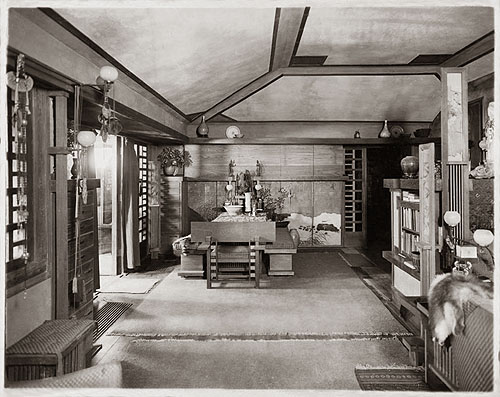 |
|
1: Dining Room,
Taliesin II, Circa 1917-1919. Taliesin II was photographed
again by Henry Fuermann and Sons circa 1917-1919, clearly
showing three Print Stands. There are many similarities
which date the 1915 image and this image close together. The
vase on the top shelf in the far left corner. Many items
decorating the dining room table are exactly the same. The
print and print stand on the far right atop the end table
are the same. But there are also subtle changes that would
date it at a later time. The adjustable wall lamp on the
left has been adjusted differently and has been adorned. The
print stand on the left has been moved. The ceiling in the
far left corner has added triangles. The figurine that was
setting on the base of the Print Stand on the far right has now been moved to the dining table
centerpiece. The small throw rug that was running
horizontally just to the right of the dining table is now
placed vertically. The Winged Victory model on the right has
been replaced by a vase. The book shelves are now full of
books. The third print stand that was on the left has been
moved to the right as well as matching wall lamp on the
right. A pelt has also been draped over a chair on the far
right as well as the dining room bench on the left. There
are many more plates and vases. |
| |
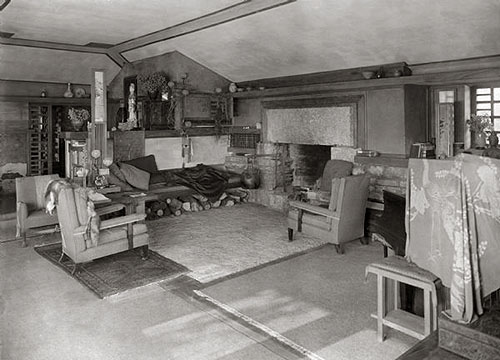 |
| |
| |
| |
|
|
Adaptation of the Table Top Print
Stand |
|
|
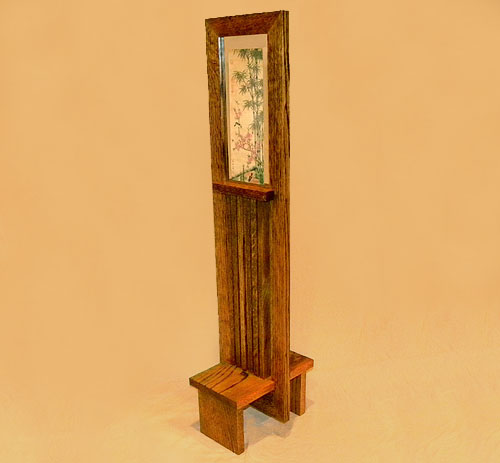 |
|
1: During November, 2010
my son-in-law, James C. Rust gave us a table top version of
the Print Stand. Without original plans to work with, he
created a very accurate adaptation of the shorter table top
Print Stand. The print was held in a tall vertical frame
that intersected the base, and floated above the surface it
was placed on. The low base was designed to hold a small
vase for flower arrangements or other decorative items. The
overall design was very consistent with Wright’s prairie
style. Thirty-six inches in height, eight in width and ten inches in depth, it is made of oak, stained with
walnut, and coated with a satin finish. What once was an
obscure two dimensional element has come to life as a
detailed three dimensional object illustrating the mind of
Frank Lloyd Wright. |
|
|
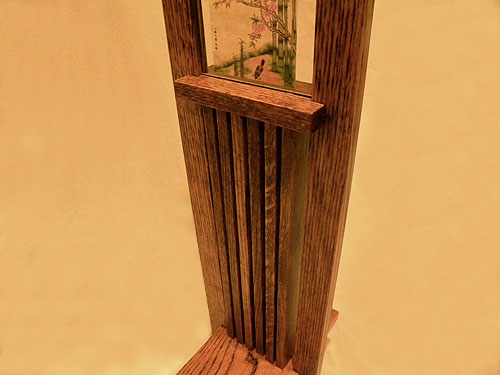 |
|
2:
The print was held in a tall vertical frame that intersected
the base, and floated above the surface it was placed on.
The overall design was very consistent with Wright’s prairie
style. |
|
|
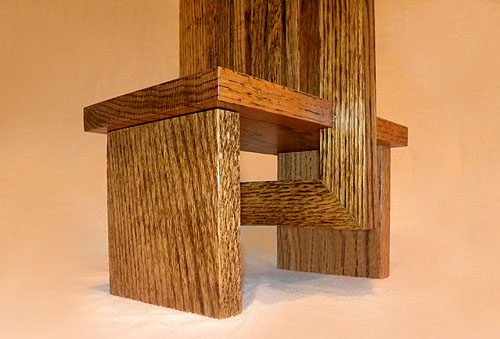 |
|
3:
The print was held in a tall vertical frame that intersected
the base, and floated above the surface it was placed on.
The low base was designed to hold a small vase for flower
arrangements or other decorative items. Eight inches in width and
ten inches in depth, it is made of oak, stained with
walnut, and coated with a satin finish. |
|
|
|
|
|
|
|
|
Sherman M. Booth Floor Lamp Circa 1915 |
|
|
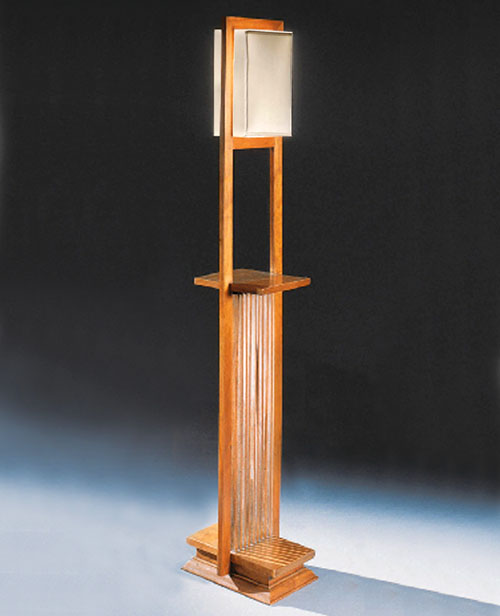 |
|
Of interest is
the Sherman M. Booth Residence (1915 - S.187) adaptation of
the Print Stand as a Floor Lamp. Booth, Wright’s attorney
and a developer, first approached Wright in 1911 to design
an
elaborate home
in Glencoe, on Chicago’s North Shore. Wright was asked
to scale back the design, and in 1915 the Booth Residence
was constructed, along with three sculptures
(S.185.1-185.3), a bridge (S.186) and five other homes
(S.188-192). Built for the Residence in 1915, the Lamp
measures sixty-five inches high, 10 inches wide and 14
inches deep. Constructed of mahogany, the shade is a silk
fabric, with the horizontal element just below the Print was
enlarged to form a shelf below the shade just above mid
point. The base is a different design. Courtesy of
Christie's. |
| |
| |
| Copyright Douglas M.
Steiner unless otherwise noted. |
|
|
|
|
|
|
|
|
Related Books and Articles |
|
|
|
The Caxton Club of Chicago,
1895. |
| "Hiroshige:
An Exhibition of Colour Prints from the collection of Frank Lloyd
Wright", Wright, 1906. |
|
"The
Art Institute of Chicago. Catalogue of a Loan Exhibition of Japanese
Colour Prints March 5 to March 25 1908", AIC, 1908. |
| "The
Architectural Record", October, 1915, Pages 385-395. |
| "In
The Nature of Materials: 1887 - 1941",
Hitchcock, 1942, plate 177. |
|
"Frank Lloyd
Wright to 1910",
Manson, 1958, Page 40. |
|
"Taliesin
1911-1914: Wright Studies Volume 1",
Menocal, 1992, Pages 48-49, 108-111. |
|
"Frank
Lloyd Wright’s Fifty Views of Japan", Birk, 1996. |
|
"Sherman
M. Booth House", 1999, Poster of Scheme 1. |
|
"Frank
Lloyd Wright
and the Art of Japan",
Meech, 2001, Pages 57-61,106-110. |
|
"Frank
Lloyd Wright:
Graphic Artist",
Fowler, 2002, Pages 25-30, 45-48. |
|
Wisconsin Magazine of
History, Autumn 2005, "An
Ebay Coup", Holzhueter, Pp 46-51. |
|
"Decorative Designs", Hanks,
1979, Page 128. |
|
Additional information about Wright
and Japan. |
| |
|
|
|
|
|
|
|
|
|





















